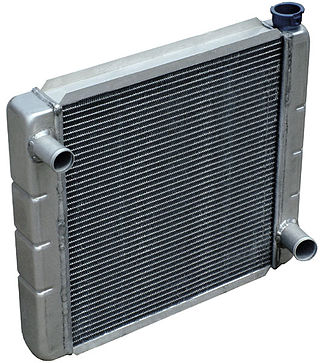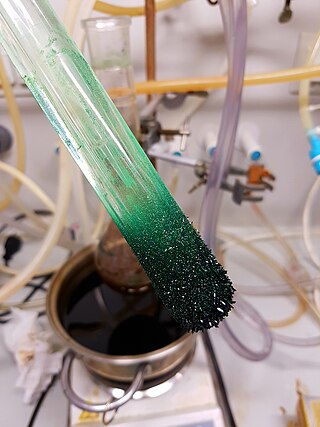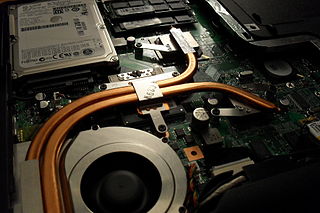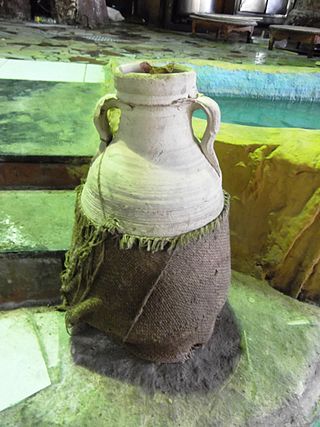
A space suit or spacesuit is a garment worn to keep a human alive in the harsh environment of outer space, vacuum and temperature extremes. Space suits are often worn inside spacecraft as a safety precaution in case of loss of cabin pressure, and are necessary for extravehicular activity (EVA), work done outside spacecraft. Space suits have been worn for such work in Earth orbit, on the surface of the Moon, and en route back to Earth from the Moon. Modern space suits augment the basic pressure garment with a complex system of equipment and environmental systems designed to keep the wearer comfortable, and to minimize the effort required to bend the limbs, resisting a soft pressure garment's natural tendency to stiffen against the vacuum. A self-contained oxygen supply and environmental control system is frequently employed to allow complete freedom of movement, independent of the spacecraft.

A radiator is a heat exchanger used to transfer thermal energy from one medium to another for the purpose of cooling and heating. The majority of radiators are constructed to function in cars, buildings, and electronics.

A dehumidifier is an air conditioning device which reduces and maintains the level of humidity in the air. This is done usually for health or thermal comfort reasons, or to eliminate musty odor and to prevent the growth of mildew by extracting water from the air. It can be used for household, commercial, or industrial applications. Large dehumidifiers are used in commercial buildings such as indoor ice rinks and swimming pools, as well as manufacturing plants or storage warehouses. Typical air conditioning systems combine dehumidification with cooling, by operating cooling coils below the dewpoint and draining away the water that condenses.

Sublimation is the transition of a substance directly from the solid to the gas state, without passing through the liquid state. The verb form of sublimation is sublime, or less preferably, sublimate. Sublimate also refers to the product obtained by sublimation. The point at which sublimation occurs rapidly is called critical sublimation point, or simply sublimation point. Notable examples include sublimation of dry ice at room temperature and atmospheric pressure, and that of solid iodine with heating.

A heat pipe is a heat-transfer device that employs phase transition to transfer heat between two solid interfaces.

An evaporative cooler is a device that cools air through the evaporation of water. Evaporative cooling differs from other air conditioning systems, which use vapor-compression or absorption refrigeration cycles. Evaporative cooling exploits the fact that water will absorb a relatively large amount of heat in order to evaporate. The temperature of dry air can be dropped significantly through the phase transition of liquid water to water vapor (evaporation). This can cool air using much less energy than refrigeration. In extremely dry climates, evaporative cooling of air has the added benefit of conditioning the air with more moisture for the comfort of building occupants.
Liquid cooling refers to cooling by means of the convection or circulation of a liquid.

A mechanical counterpressure (MCP) suit, partial pressure suit, direct compression suit, or space activity suit (SAS) is an experimental spacesuit which applies stable pressure against the skin by means of skintight elastic garments. The SAS is not inflated like a conventional spacesuit: it uses mechanical pressure, rather than air pressure, to compress the human body in low-pressure environments. Development was begun by NASA and the Air Force in the late 1950s and then again in the late 1960s, but neither design was used. Research is under way at the Massachusetts Institute of Technology (MIT) on a "Bio-Suit" System which is based on the original SAS concept.

The Extravehicular Mobility Unit (EMU) is an independent anthropomorphic spacesuit that provides environmental protection, mobility, life support, and communications for astronauts performing extravehicular activity (EVA) in Earth orbit. Introduced in 1981, it is a two-piece semi-rigid suit, and is currently one of two types of EVA spacesuits used by crew members on the International Space Station (ISS), the other being the Russian Orlan space suit. It was used by NASA's Space Shuttle astronauts prior to the end of the Shuttle program in 2011.

A chiller is a machine that removes heat from a liquid coolant via a vapor-compression, adsorption refrigeration, or absorption refrigeration cycles. This liquid can then be circulated through a heat exchanger to cool equipment, or another process stream. As a necessary by-product, refrigeration creates waste heat that must be exhausted to ambience, or for greater efficiency, recovered for heating purposes. Vapor compression chillers may use any of a number of different types of compressors. Most common today are the hermetic scroll, semi-hermetic screw, or centrifugal compressors. The condensing side of the chiller can be either air or water cooled. Even when liquid cooled, the chiller is often cooled by an induced or forced draft cooling tower. Absorption and adsorption chillers require a heat source to function.

Nomex is a flame-resistant meta-aramid material developed in the early 1960s by DuPont and first marketed in 1967.
A coolant is a substance, typically liquid, that is used to reduce or regulate the temperature of a system. An ideal coolant has high thermal capacity, low viscosity, is low-cost, non-toxic, chemically inert and neither causes nor promotes corrosion of the cooling system. Some applications also require the coolant to be an electrical insulator.

Freeze-dried ice cream, also called astronaut ice cream or space ice cream, is ice cream that has had most of the water removed from it by a freeze-drying process. Compared to regular ice cream, it can be kept at room temperature without melting, is dry and more brittle and rigid, but still soft when bitten into. It was developed by Whirlpool Corporation under contract to NASA for the Apollo missions. However, it was not used on any Apollo mission. Freeze-dried foods were developed so that foods could be sent on long-duration spaceflights, and to reduce the weight of the water and oxygen normally found in food. The process of freeze-drying also eliminates the possibility of food melting and spilling as liquid in zero-gravity, which would be problematic.

The Apollo/Skylab space suit is a class of space suits used in Apollo and Skylab missions. The names for both the Apollo and Skylab space suits were Extravehicular Mobility Unit (EMU). The Apollo EMUs consisted of a Pressure Suit Assembly (PSA) aka "suit" and a Portable Life Support System (PLSS) that was more commonly called the "backpack". The A7L was the PSA model used on the Apollo 7 through 14 missions.

Vapour-compression refrigeration or vapor-compression refrigeration system (VCRS), in which the refrigerant undergoes phase changes, is one of the many refrigeration cycles and is the most widely used method for air conditioning of buildings and automobiles. It is also used in domestic and commercial refrigerators, large-scale warehouses for chilled or frozen storage of foods and meats, refrigerated trucks and railroad cars, and a host of other commercial and industrial services. Oil refineries, petrochemical and chemical processing plants, and natural gas processing plants are among the many types of industrial plants that often utilize large vapor-compression refrigeration systems. Cascade refrigeration systems may also be implemented using two compressors.

Beta cloth is a type of fireproof PTFE impregnated silica fiber cloth used in the manufacture of Apollo/Skylab A7L space suits, the Apollo Thermal Micrometeoroid Garment, the McDivitt Purse, and in other specialized applications.

A primarylife support system (PLSS), is a device connected to an astronaut or cosmonaut's spacesuit, which allows extra-vehicular activity with maximum freedom, independent of a spacecraft's life support system. A PLSS is generally worn like a backpack. The functions performed by the PLSS include:

An (Integrated) Thermal Micrometeoroid Garment is the outer layer of a space suit. The TMG has three functions: to insulate the suit occupant and prevent heat loss, to shield the occupant from harmful solar radiation, and to protect the astronaut from micrometeoroids and other orbital debris, which could puncture the suit and depressurize it.
A Maximum Absorbency Garment (MAG) is an adult-sized diaper with extra absorption material that NASA astronauts wear during liftoff, landing, and extra-vehicular activity (EVA) to absorb urine and feces. It is worn by both male and female astronauts. Astronauts can urinate into the MAG, and usually wait to defecate when they return to the spacecraft. However, the MAG is rarely used for this purpose, since the astronauts use the facilities of the station before EVA and also time the consumption of the in-suit water. Nonetheless, the garment provides peace of mind for the astronauts.

Pumpable icetechnology (PIT) uses thin liquids, with the cooling capacity of ice. Pumpable ice is typically a slurry of ice crystals or particles ranging from 5 micrometers to 1 cm in diameter and transported in brine, seawater, food liquid, or gas bubbles of air, ozone, or carbon dioxide.



















